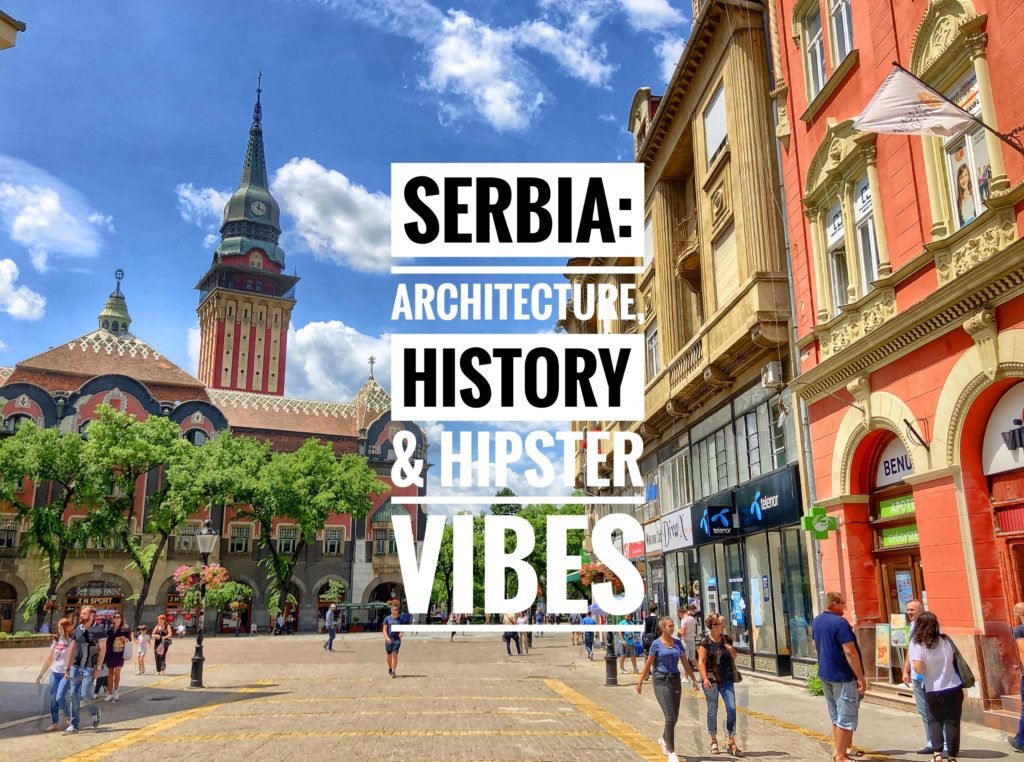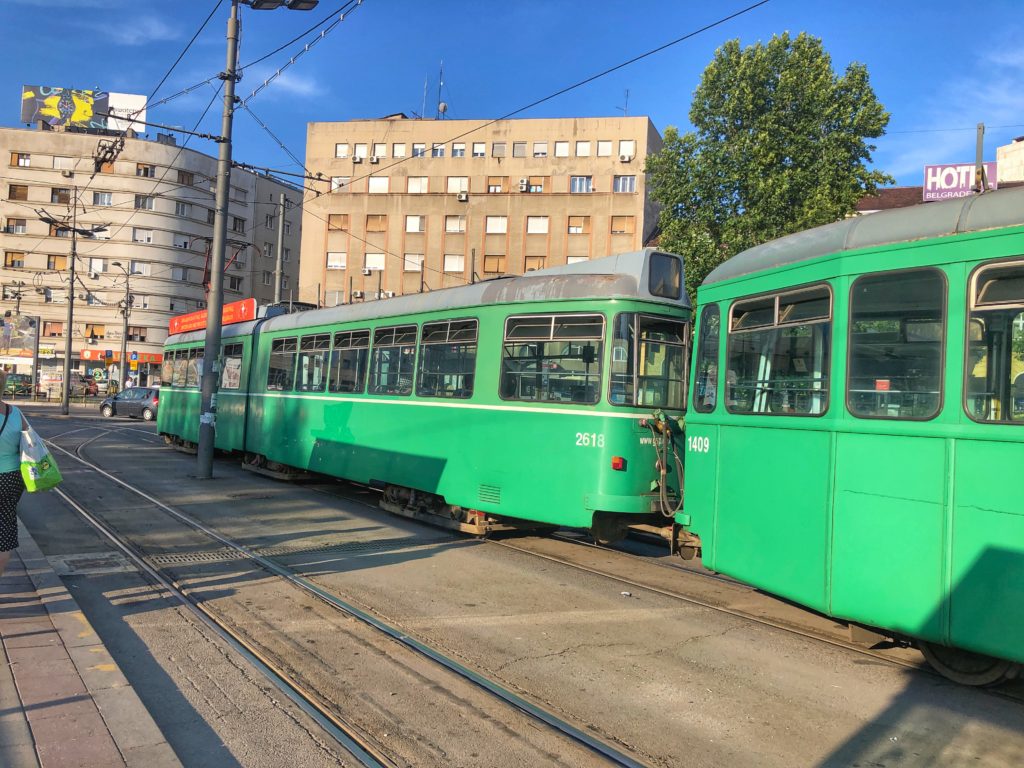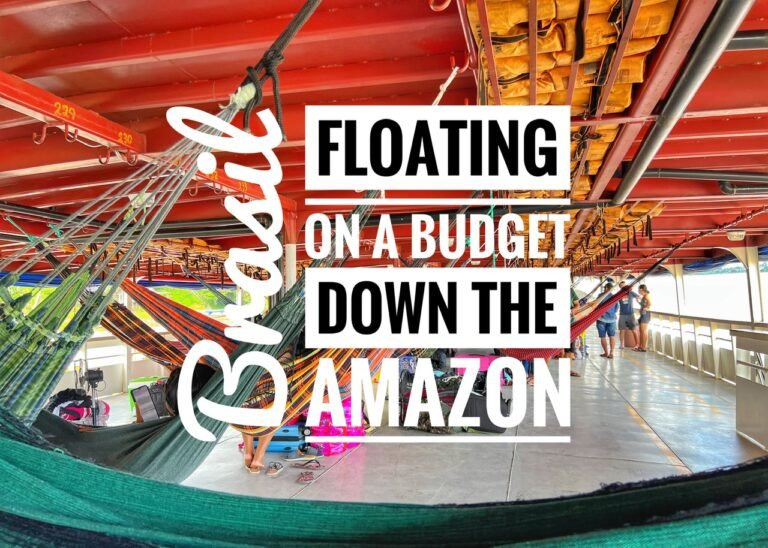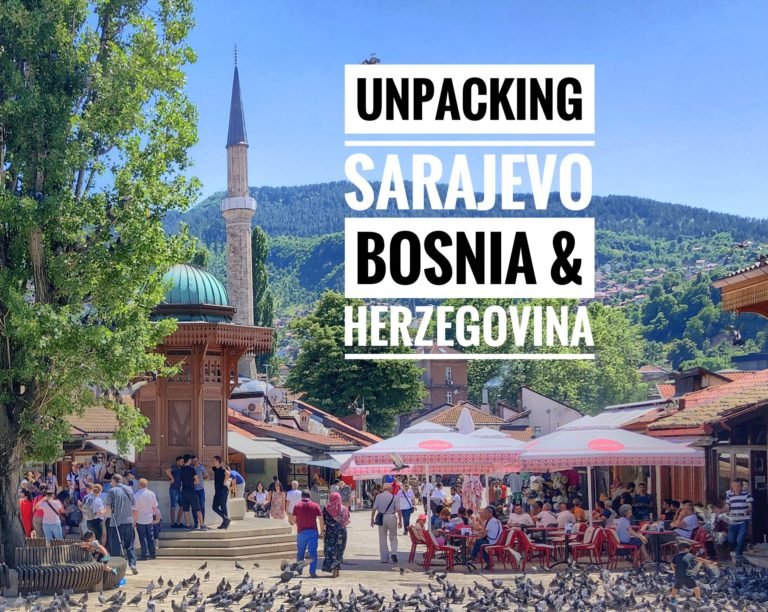
We breathed a sigh of relief when we got to Serbia. No tour buses, no fanny packs, no tourist scams. Instead we found creative hipster vibes and nightlife in Belgrade, colorful Austro-Hungarian architecture in the northern Vojvodina province on the banks of the Danube, and a simply quaint city in the birthplace of Constantine the Great. Indeed, landlocked Serbia is packed with a different kind of exploration than its neighbors.
So, why so few tourists? Despite being a very important country politically and one of the bigger on a geographical scale, it’s kind of left in the dust as a “best of” destination in the Balkans and is certainly not overhyped on the tourism meter. This means it may not have the best scenery (go to Albania), the best places for relaxing (try Montenegro), or the best food (we prefer Bulgaria.)
That said, even though it may not be the “best,” at certain things, it makes it all the more appealing. The lack of tourists provided us with very authentic, local and inexpensive experiences. And it is well worth a stop on a tour through the Balkans.

Getting to Belgrade from Zabljak, Montenegro wasn’t really part of the fun. In fact, it sucked. (Ha, here’s to killing the myth that we live a glamorous, stress-free lifestyle.) Our first bus decided to take the day off so we had to wait 3.5 hours on a super plush wooden bench, followed by a 9.5 hour ride in this hot box with no A/C and windows that are apparently designed only for collecting streak marks, handprints and filth. At last, we finally rolled into Serbia’s capital just in time to greet all the partygoers with our ready-for-action grins and backpacks!
We proceeded to argue about whether or not to take a taxi, or walk the 30 minutes to our hostel. Then, frustrated, decided on the bus not having a clue how to get a ticket because the stone-faced driver just waved us on, and deposited us on the other side of the river from where we needed to be. Needless to say, we rolled into our hostel at about 1 am and then got the pleasure of dealing with the boisterous Indians on the smoking balcony conveniently located next to our only available private room. So we grunted at each other, stuffed in our earplugs, and reminded ourselves we are living the dream.

The next day, fortunately, things were looking brighter as we set out to do the free walking tour of the city, which left from Republic Square, home of the National Museum of Belgrade pictured here.

Hotel Moskva, a grand art nouveau hotel built following WW1. Many elite visitors to Belgrade have stayed here, including Albert Einstein according to our guide. Einstein’s first wife incidentally, was a Serbian physicist.

This swanky residence is home to Belgrade’s mayor. Whenever Serbian athletes are successful in major competitions they are invited to stand on the upper balcony in a ceremony to honor their achievements. When the Serbian Olympic volleyball(?) team won against team U.S.A. (??) they were invited to celebrate but were too numerous to fit on the balcony, so instead stood in front of the parliament building across the street.

The House of the National Assembly of the Republic of Serbia (parliament), with a rather odd and provocative sculpture out front. According to our guide, apparently the sculptor, who was commissioned in the 1920s to create it for the newly constructed parliament was a (Bolshevik?/egalitarian?) who believed government was the enemy of the people, and decided to rather coyly express his anti-government beliefs through this sculpture. The funny thing is, his subtle critique went unnoticed by his benefactors…the government. Here’s the Cliff Notes version in case you can’t make out the symbolism… the beautifully strong and austere-looking horse is the government, but man in actuality is supporting it and struggling to pull the immense beast forward while being crushed under its weight.

This old man decides to have a rest in front of this lovely Serbian Orthodox Church.

This is the former home of a Serbian state television station. It was bombed by NATO in April 1999, with support from the US, on the assumption it was helping to spread war propaganda. Many civilians were injured and killed.

This is a very large Serbian Orthodox Church/Cathedral that began its construction at a very unfortunate time…six months before WWI came to Belgrade. Of course construction was halted at that time. Then, restarted in 1940 only to be halted again at the outbreak of WWII. Then restarted again, at the conclusion of WWII, but then stalled again once communism established itself in Yugoslavia and funding was eliminated. The church languished half-built for decades before finally being restarted in the last decade, and they are still constructing it… Therefore, it has amazingly taken over a hundred years to construct it. Ah well, at least that’s better than La Sagrada Familia.

After the walking tour, it was time for some lunch. But this was one restaurant we easily crossed off the list.
The Belgrade historic street car from the 1960’s. An all day transportation pass was $2.25/ticket.

And lo and behold! What could it be?! Our future endeavor plopped in the heart of Belgrade…
Strolling the welcoming streets of the Skadarska neighborhood. They were packed with live Serbian music, delightful smells and vivid images. We loved how they had recreated communist concrete block facades into artsy palates of inviting street scenes.
Stumbling upon a little piece of Portland tucked within old warehouses in Belgrade… Dorćol Platz. This cafe-light-strung quirky pod featured graffiti, art installations, a brewery, vintage toy airplane toys for kids to pretend to be pilots in, restaurants/bars, and lots of urban chic & hipster kitsch. Craft beers were about $2.50 and more than accessible in Serbia. Probably the most beer-centric place in the Balkans.
Life is indeed beautiful because another godsend we found in Belgrade was Mexican food. It had been five long months since any form of salsa had graced our tongues, and although it was probably more Chipotle caliber than anything authentic, it tasted absolutely spectacular to us. We even managed to get three whole slices of jalapeño peppers, which Mandy immediately confiscated for her own. ?

Look! We even found a hipster IN a Salt & Straw-like shop, complete with obscure ice cream flavors.

Would love to know the story behind this fantastic street mural?

One of the fun things about Serbia is the feeling of being loaded with these colorful, high-number clad notes. This 1600 Serbian Dinars is equivalent to about $16. It’s kind of a unique system because there are only a couple of coins and the 10 dinar notes are equivalent to about $.10. This means your wallet is constantly stuffed with a wad of notes, with the lower ones often being especially grubby.

Another great thing about Serbia is access to cheap and comfy trains. From Belgrade, we headed north to the lively city of Novi Sad, which is in the Vojvodina province.

A two-hour train trip ($3.25) takes you to a fairy-tale empire near the Hungarian border called Subotica. If there was any question you were back in Austro-Hungarian Land it would probably be answered in this town packed with colorful Art Nouveau flair. But of course, like other places in this region, Subotica (and Vojvodina overall) has a long history and has changed rulers, countries and names dozens of times and has been under the governance of the Hungarians, Serbs, and Turks. So…like with Kosovo…which we’ll get to later, who it really “belongs” to is still a hotly contested issue and another endless rendition in the “who was here first” Balkan edition.
Thank you for the info. We’ll just stand here and look at the pretty buildings.

And there is a LOT to look at. Every single building could be studied at great length for artistic images and detail. Subotica reached its golden period during the beginning of the 20th Century. At one point it was the third largest city in the Kingdom of Hungary.

Although holy sites often dominate the central square, the City Hall finished in 1912 is the central icon of Subotica. The decorative features of Art Nouveau are enriched with a romantic nuance of the Hungarian Empire and the floral elements and mosaic ceramic tile roof definitely make it the most stunning city halls we’ve ever seen!

A broader shot of the colorful and whimsical City Hall. Disney should take notes on this town.

Thanks to their turbulent and extensive history, an example of how language is impacted. In Subotica, it’s common to find signs in Hungarian, and Serbian-Croat…both in Latin and Cyrillic varieties. The Cyrillic alphabet is still used but may eventually be phased out as it seems younger people prefer the Latin alphabet, along with learning English.

By far, the most jaw-dropping synagogue we’ve ever seen. According to the World Monuments Fund, “the synagogue in Subotica was originally designed as part of the architectural competition for the synagogue in Szeged by architects Dezső Jakab and Marcell Komor and became one of the most innovative Jewish places of worship in the Hapsburg Empire. This was the first synagogue to utilize the new architectural language of Hungarian Art Nouveau, which expressed the loyalty of the Jews to the Hungarian nation and at the same time enabled them to break away from tradition and create a modern building.”
It is dedicated to the 4000 Jews who perished in Nazi death camps during the war.

The Franciscan Church, obviously in need of some super glue, has a very impressive crack that runs the length of it. Wow, how do you even go about gluing a church of this size back together?!?

You might even get to save the day for someone who’s stuck!
Don’t forget to look up. Everywhere you look in Subotica is interesting!

The curvaceous, grand and fanciful Raichle Palace was built in 1904 by Ferenc Raichle. His Art Nouveau-style is found in many places in Subotica, as well as neighboring Szeged, Hungary.

On the train ride back, miles and miles of sunflowers stand like alert and conforming little soldiers.
Back in Novi Sad. Such a chipper city with a good buzz. Trying to fit in as locals on the promenade in Novi Sad. Every night they would offer free live music in the park. Most nights it was just one silver haired Serbian playing a clarinet but on the weekends he brought all his friends for a rocking good time. It was a fantastic place to be based for five days and we even managed to get in a routine in our cozy little studio. It was right near the Old Town and a block away from the Danube, which Mandy would wake up and run along.
The twisting, turning Danube meanders its way through 10 countries as the longest river in Europe, running all the way from southwest Germany to the Black Sea. This is our fifth time on this trip we’ve brushed fingers with it.

One of our evening walks along the Danube. In the background you can see the moon rising over Petrovaradin Fortress, completed in 1780. It has 16k of underground tunnels tucked under it and is now renowned as the location of the EXIT music festival.
The award-winning international EXIT festival is an annual summer music festival that has been held at the fortress since its inception in 2001. We purposefully missed it by a hair arriving three days after its wrap-up. Apparently, it has grown from the biggest festival in South-Eastern Europe, to one of the biggest in Europe. Names such as Garbage, Billy Idol, Guns ‘N Roses, Lauryn Hill and Beastie Boys have performed here.
Another easy day trip from Novi Sad is a little wine and cultural treasure called Sremski Karlovci, which is about 20 minutes by local bus. ($1.30) When we arrived, our instinct was to find the highest place available for a lay of the land. We looked for the gold cross to climb Vidikovac hill, a swift climb of about 15 minutes offering an unforgettable view of the town and the winding Danube.

Walking through Sremski Karlovci, we stumbled upon this 300-year-old sycamore tree and have to admit, were impressed. Certainly the biggest of its kind we’ve seen. Greg stands under it for scale.

We weren’t really impressed, however, until we admired this beauty from afar. Believe it or not that is the ONE tree swallowing up that church!
It was then time to participate in the activity that brings most to Sremski Karlovci…wine tasting in the ancient cellars. So we slipped into this one and tasted some delightful Bermet, a dessert wine that is a speciality in this region originally intended for medicinal purposes, but later produced for regular consumption. Because it was so delightful, we then proceeded to drop all of our money on a bottle, not realizing Mandy had forgotten “the vault” (aka back-up cash and debit card) back in the room.

Oh…shitballs. First time on this trip we had literally no money or way to get it. So, after finagling our way through what to do, we realized our best option was to hoof it 12k (~7 miles) back to Novi Sad, attempting to find gratefulness in the fact that it was a cloud-covered day, and we were wearing walking shoes. Fortunately the roads were mostly pleasant.
And because we had spent our lunch money on wine and were also quite hungry, we were happy to find lots of varieties of plums to snack on along the road. Greg even challenged Mandy to see how many plums she could stuff in her mouth. Hey, at least we can entertain ourselves when times get tough.
Moving on from Novi Sad, we headed to Serbia’s south, the third biggest city of Nis. We were mostly using it to break up the journey onto Kosovo, and we also wanted to visit the famous Skull Tower. The Skull Tower is a stone structure made of skulls from rebel fighters used as a scare tactic by the Ottoman Empire to elicit fear among its opponents. Unfortunately, this picture was taken by Atlas Obscura not us, because the one day we were there (Monday), it was frustratingly closed.
Ah, well. We still got to enjoy a pretty sunset by the river.

And visit the plaque which honors Rome’s first Christian emperor, Constantine the Great, who established Christianity as the official religion of the Roman Empire in 313 AD and also founded Constantinople.
Nis also has a well-preserved fortress dating 2000 years old, that now encircles a gorgeous park. It is assumed that the Roman fortress was built of stone in the middle of the 2nd century when Niš first appeared in written sources.
Inside the fortress is a beautiful mosque called Bali Bey built when the Ottomans took over in the early 1700’s.

Arriving to the bus station at 7 am to head to Kosovo. After standing at the platform for a good half-hour, we eventually discovered the bus was 1.5 hours late. Ah, well. Guess we’ll just enjoy the cloud of smoke the locals puff at you. Yes, we do miss the smoking laws of the EU…
Serbia Wrap-Up
Time Spent: 9 nights
Money Spent: $405.96 or $45.10/day
Budget Travel Meter*: $$$
Things we loved about Serbia:
- The hipster vibe of Belgrade
- The brilliant colors and Art Nouveau handiwork in Vojvodina
- Eating Mexican food…ha!
- Readily available craft breweries
- Sremski Karlovci & Subotica—both absolute gems and really rewarding day trips
Things that could’ve been better:
- The jerks that stayed at our hostel in Belgrade. They were completely disrespectful, destroyed the kitchen everyday and stole our food.
- The train availability. Although there were a ton of lines, half of them were under repair or only available 1-2 times a day at awkward times
- We heard a lot of negativity from the locals. They seem to have a lot of hang-ups about the past.
Would we go back? Probably once was enough.
Budget Travel Meter* The Budget Meter gauges how hard it was for us to stick to our $50/day budget. We’re factoring our Budget Meter by our daily food consumption options.
- $ – Eating-out up to twice a day and ordering whatever the hell we want, with dessert!
- $$—Eating-out once a day in a restaurant of our choice
- $$$—Eating-out once a day, on cheap pizza or local street food meals, usually involving copious amounts of filling bread
- $$$$—Eating-in every meal, healthy/fresh & in-season produce options
- $$$$$—Eating powdered soup & potatoes for every meal.


























Hey Greg. Love the blog. Would love to be included.
Hey Jim! Great to hear from you 🙂 Absolutely, we’d be happy to add you. Thanks so much, and hope you’re doing well!